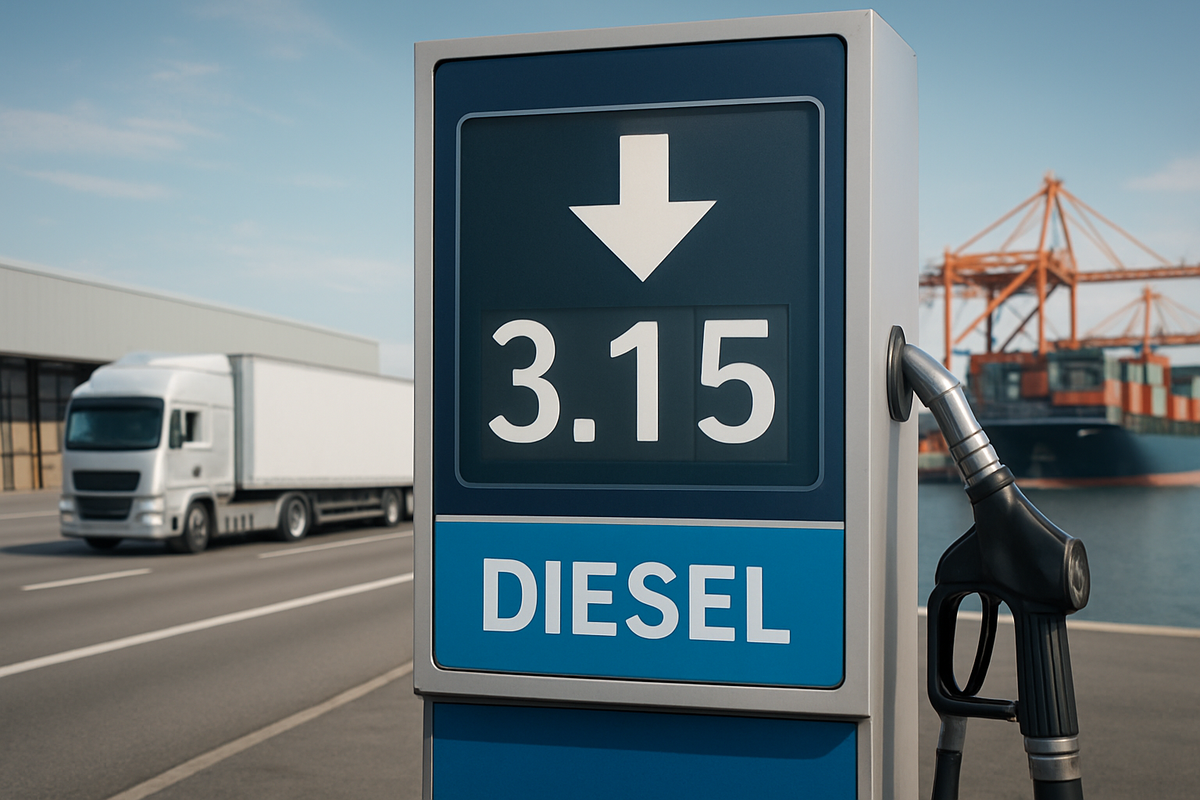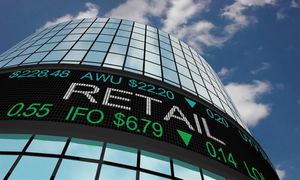
After a prolonged period of escalating costs that squeezed profit margins and fueled inflation, benchmark diesel prices are experiencing a significant decline, offering a much-needed reprieve for the transport and logistics industries. This recent downturn, observed over several consecutive weeks, marks a notable reversal from the multi-year highs seen between 2021 and 2024, when geopolitical conflicts, supply chain disruptions, and robust demand pushed prices to unprecedented levels. The immediate implication is a potential easing of operational burdens for carriers, a reduction in shipping costs, and a broader stabilization of market prices for goods.
The shift in diesel dynamics is poised to ripple through the global economy, impacting everything from consumer prices to corporate profitability. While lower fuel costs promise increased margins for freight companies and could stimulate economic activity, the rapid change also presents a complex landscape for businesses that have adapted to a high-cost environment. Stakeholders across the supply chain are now recalibrating strategies to navigate this new, more favorable fuel price reality, with an eye on both the immediate benefits and the longer-term market adjustments.
Unpacking the Diesel Downturn: A Shift in Global Energy Dynamics
The recent decline in benchmark diesel prices is a significant development, especially considering the challenging environment that preceded it. From 2021 through much of 2024, the global energy market was characterized by a relentless surge in diesel prices. This was primarily fueled by a potent mix of factors: a robust rebound in demand following the COVID-19 pandemic, persistent bottlenecks in global supply chains, and, crucially, the disruptive impact of geopolitical conflicts, particularly the Russia-Ukraine war. The conflict notably created a diesel shortfall in Europe, forcing a global rerouting of supplies and exerting immense upward pressure on prices worldwide. U.S. diesel prices, for instance, soared to over $4.00 per gallon in early 2024, reflecting the tight market conditions.
However, the tide has turned dramatically in recent weeks, with benchmark retail diesel prices falling for three consecutive weeks, reaching their lowest point since mid-June. This decline amounts to a significant 13.4 cents per gallon drop over that period, settling at an average of $4.62 per gallon. Globally, this trend is mirrored, with reports from regions like India indicating sharp reductions of approximately ₹2.33 per liter in November 2025. While European benchmark diesel prices have also decreased, albeit remaining somewhat elevated compared to late October levels, the overarching sentiment points to a cooling market. The U.S. Energy Information Administration (EIA) (EIA:US) projects a further decline, forecasting an average of $3.50 per gallon in 2026, a 7% decrease from 2024 levels.
Several key factors are driving this reversal. A primary contributor is the growing imbalance between global oil supply and demand, with global production surging and overwhelming modest consumption growth, leading to fears of an impending supply glut. This is exacerbated by decreased crude oil prices, as diesel is a derivative of crude. Brent crude, a global benchmark, has reached multi-year lows. Furthermore, increased domestic oil production in the U.S. and the resumption of Libyan oil production have bolstered supply. Weakened global demand, stemming from slower industrial activity, soft freight volumes, and general economic sluggishness outside the U.S., particularly in Europe and Asia, is also playing a critical role. Structural changes in demand, such as the accelerated adoption of electric vehicles (EVs), the emergence of LNG-powered trucks, and a slump in the property sector in major markets like China, are also contributing to a plateau in underlying fuel demand.
The immediate reactions from the transport and logistics sectors have been largely positive, albeit cautiously so. Companies are anticipating reduced fuel surcharges and lower operating costs, which could lead to increased profit margins for carriers and potentially more competitive pricing for shippers. Public transport services and commercial vehicle owners are also set to benefit from reduced expenses. However, for owner-operators and drivers paid on a percentage basis, lower fuel surcharges could translate into reduced overall revenue, necessitating careful financial planning. The stabilization of geopolitical tensions in some regions, particularly Europe, has also helped normalize supply routes, further alleviating pricing pressures.
Navigating the Shifting Tides: Winners and Losers in the Diesel Price Decline
The recent decline in benchmark diesel prices is poised to create a distinct set of winners and losers across various industries, fundamentally altering cost structures and competitive landscapes. For companies heavily reliant on fuel for their operations, this downturn represents a significant financial relief and a potential boost to profitability.
The Winners:
- Transport and Logistics Companies: This sector stands to be the most direct beneficiary. Major freight carriers like FedEx (NYSE: FDX) and UPS (NYSE: UPS), along with countless smaller trucking firms, will see a direct reduction in their largest variable cost: fuel. Lower fuel surcharges will improve their profit margins, allowing them to either reinvest in their fleets, technology, and services, or pass on savings to customers, thereby gaining a competitive edge. Companies specializing in last-mile delivery and regional transport will also experience substantial operational savings.
- Airlines and Shipping Lines: While the focus is on diesel, a broader decline in crude oil prices often correlates with lower jet fuel and bunker fuel costs. This could benefit airlines like Delta Air Lines (NYSE: DAL) and American Airlines (NASDAQ: AAL), as well as global shipping giants such as Maersk (CPH: MAERSK-B), by reducing their operational expenditures.
- Manufacturing and Retail Sectors: Companies that rely on extensive supply chains to move raw materials and finished goods will benefit from lower transportation costs. Manufacturers like General Motors (NYSE: GM) and retailers such as Walmart (NYSE: WMT) will see reduced inbound and outbound logistics expenses, which could translate into higher profit margins or the ability to offer more competitive pricing to consumers. This could help mitigate inflationary pressures.
- Consumers: Ultimately, lower transportation costs for goods and public services can lead to lower prices for a wide range of products, from groceries to electronics. Public transport operators, benefiting from cheaper diesel, may be able to keep fare increases in check, providing relief to commuters.
The Potential Losers or Those Facing New Challenges:
- Fuel Producers and Refiners: Companies involved in the exploration, production, and refining of crude oil and diesel may see reduced revenues and profit margins as prices decline. This includes integrated oil and gas majors like ExxonMobil (NYSE: XOM) and Chevron (NYSE: CVX), as well as independent refiners. While lower crude input costs might offer some offset for refiners, a significant drop in the spread between crude and refined products could be detrimental.
- Alternative Fuel Providers (Short-term): In the short term, the reduced cost of traditional diesel might make alternative fuels, such as electric vehicle charging or compressed natural gas (CNG), less economically attractive for some fleet operators. This could slow down the adoption rate of newer, cleaner technologies, impacting companies investing heavily in these areas. However, the long-term trend towards decarbonization is likely to persist.
- Owner-Operators and Independent Truckers (Paradoxically): While lower fuel prices reduce their direct expenses, these independent operators often rely on fuel surcharges as a significant component of their overall revenue. If freight brokers and shippers reduce these surcharges in line with falling fuel costs, owner-operators, particularly those paid on a percentage basis, could see their gross income decrease, despite lower fuel outlays. This necessitates careful financial management and negotiation strategies.
- Companies with Hedging Strategies: Businesses that had aggressively hedged their fuel costs at higher prices might find themselves at a disadvantage if spot market prices continue to fall significantly below their hedged rates. While hedging protects against price spikes, it can also limit benefits from price declines.
The overall impact is a rebalancing of economic forces. While the transport-intensive sectors are poised for a significant uplift, the energy production segment will face headwinds. The key for all players will be agility in adapting to these new market conditions and leveraging the opportunities or mitigating the risks presented by the shifting price landscape.
Broader Implications and Historical Context of Diesel Price Volatility
The recent decline in benchmark diesel prices is more than just a temporary market fluctuation; it represents a significant shift with wider implications that resonate across various sectors and economic policies. This event fits into broader industry trends, particularly the ongoing tug-of-war between global supply and demand dynamics, and the accelerating transition towards sustainable energy.
From a broader industry trend perspective, the decline highlights the cyclical nature of commodity markets and the profound impact of geopolitical stability (or instability) on energy prices. The preceding period of high diesel prices pushed many transport and logistics companies to invest in fuel efficiency measures, explore alternative fuels like LNG and electric powertrains, and optimize routing. While the current decline offers immediate relief, it doesn't negate the long-term trend towards decarbonization. Companies like PACCAR (NASDAQ: PCAR) and Volvo (STO: VOLV-B), which are heavily investing in electric and hydrogen trucks, might see a temporary slowdown in adoption rates if traditional diesel becomes significantly cheaper, but the regulatory push and environmental concerns will likely maintain the momentum for green logistics in the long run.
The ripple effects extend to competitors and partners. For instance, rail transport, already known for its fuel efficiency, might find itself in a more competitive position against trucking if diesel prices continue to drop, making it an even more appealing option for freight movement for companies like Union Pacific (NYSE: UNP) and BNSF Railway (BRK.A: US). Conversely, the reduced cost burden on trucking could intensify competition within the road freight sector, potentially leading to price wars as companies vie for market share. Partners in the supply chain, from raw material suppliers to end-retailers, will benefit from more predictable and lower transportation costs, allowing for better inventory management and potentially lower consumer prices.
Regulatory and policy implications are also significant. Governments, which often face pressure to stabilize energy costs and manage inflation, might find some breathing room. Lower diesel prices could reduce the urgency for certain energy subsidies or tax relief measures previously considered to support industries struggling with high fuel costs. Conversely, it might also reduce the immediate incentive for accelerated adoption of stricter emissions standards or investments in alternative fuel infrastructure, though long-term climate goals remain. The U.S. Energy Information Administration's (EIA) forecasts of continued decline could influence future energy policy decisions, particularly concerning strategic petroleum reserves and domestic oil production targets.
Historically, periods of significant diesel price volatility are not uncommon. The oil shocks of the 1970s, the price spikes following the Gulf Wars, and the financial crisis of 2008 all demonstrated how quickly energy prices can shift, impacting global economies. A more recent comparison can be drawn to the period immediately following the 2014-2016 oil glut, where sustained low crude prices led to a similar, albeit less dramatic, reduction in diesel costs. These historical precedents highlight the importance of hedging strategies and operational flexibility for businesses to weather such fluctuations. The current situation, however, is distinct due to the added layers of post-pandemic demand shifts and the ongoing energy transition, making the long-term trajectory less certain.
What Comes Next: Navigating the Future of Diesel Markets
The recent decline in benchmark diesel prices ushers in a new phase for industries heavily reliant on fuel, presenting both opportunities and challenges that will unfold in the short and long term. Understanding these potential scenarios is crucial for strategic planning and adaptation.
In the short term, we can expect continued downward pressure on fuel surcharges across the transport and logistics sectors. This immediate cost relief will likely translate into improved profitability for carriers and potentially more aggressive pricing strategies to capture market share. Companies that were struggling with razor-thin margins due to high fuel costs might see a lifeline, enabling them to stabilize operations and potentially invest in delayed maintenance or minor fleet upgrades. For consumers, the benefits could manifest as slightly lower prices for goods, contributing to a broader easing of inflationary pressures. However, the exact extent of these benefits will depend on how quickly savings are passed through the supply chain.
Looking to the long term, the trajectory of diesel prices will be influenced by a complex interplay of factors. While the current supply glut and weakened demand are driving prices down, geopolitical events, OPEC+ decisions on production cuts, and the pace of global economic recovery could quickly shift the balance. The ongoing energy transition also remains a critical long-term factor. If the adoption of electric vehicles and LNG-powered trucks accelerates, the structural demand for diesel could continue to plateau or even decline, sustaining lower prices. Conversely, any slowdown in alternative fuel adoption or a resurgence in industrial activity could reverse the trend.
Potential strategic pivots or adaptations required will be multifaceted. Transport companies may need to revisit their hedging strategies, balancing protection against future spikes with the ability to benefit from current low spot prices. Investment in fuel-efficient technologies, while less immediately critical than during high-price periods, should continue as a long-term strategy for sustainability and cost control. Logistics providers might also explore optimizing their networks to take full advantage of reduced transportation costs, potentially by consolidating routes or increasing delivery frequencies. For energy producers, the challenge will be to manage production levels to avoid further market saturation while remaining profitable.
Market opportunities or challenges that may emerge include a potential surge in demand for larger, less fuel-efficient vehicles if the cost of diesel remains low, though environmental regulations will likely temper this. There could also be increased M&A activity in the logistics sector as companies with healthier balance sheets look to acquire competitors. A significant challenge for governments and policymakers will be to balance the immediate economic relief with long-term climate goals, ensuring that lower fossil fuel prices do not derail decarbonization efforts.
Potential scenarios and outcomes range from a sustained period of lower, more stable diesel prices, fostering economic growth and reducing inflationary pressures, to a rebound driven by unforeseen supply disruptions or a stronger-than-expected global economic recovery. A "Goldilocks" scenario would involve prices remaining low enough to support economic activity but high enough to continue incentivizing investment in alternative fuels and efficiency. The coming months will be crucial in determining which path the market takes, with global economic indicators and geopolitical developments serving as key signposts.
A New Horizon for Logistics: Assessing the Lasting Impact of Diesel Price Declines
The recent and significant decline in benchmark diesel prices marks a pivotal moment for the global financial markets and, more specifically, for the intricate web of industries reliant on transportation. This shift, following a period of unprecedented highs, offers a complex blend of relief, strategic recalibration, and renewed uncertainty.
The key takeaways from this event are clear: the global energy market is undergoing a significant rebalancing, driven by increased supply, weakened demand, and structural shifts towards alternative energy. This has translated into tangible cost reductions for transport and logistics firms, promising improved profitability and potentially lower consumer prices. However, it also highlights the inherent volatility of commodity markets and the need for robust, adaptable business models. The interplay of geopolitical stability, economic growth, and the pace of energy transition will continue to dictate future price movements.
Moving forward, the market will likely see intensified competition within the logistics sector as companies leverage lower fuel costs to gain market share. There may also be a temporary easing of the urgency to adopt costly alternative fuel technologies, though the long-term push for decarbonization remains. Investors will be closely watching the earnings reports of major freight carriers and logistics providers, such as XPO Logistics (NYSE: XPO) and Old Dominion Freight Line (NASDAQ: ODFL), to gauge the extent of margin improvement and how these savings are being utilized—whether for reinvestment, debt reduction, or shareholder returns. The impact on inflation will also be a critical metric, as lower transportation costs could help moderate consumer price increases.
Final thoughts on significance and lasting impact point to a potentially more stable and predictable operating environment for many businesses. While the memory of recent fuel price spikes will undoubtedly influence future risk management strategies, the current decline offers a valuable opportunity for industries to consolidate gains, optimize operations, and invest in long-term resilience. The event underscores the interconnectedness of global markets, where shifts in energy supply and demand can have far-reaching economic consequences, from the largest multinational corporations to the smallest independent operators.
What investors should watch for in the coming months includes the sustainability of current crude oil production levels, particularly from non-OPEC+ nations, and any shifts in global demand, especially from major economies like China and Europe. Geopolitical developments, particularly those affecting key oil-producing regions or shipping lanes, will also remain critical. Furthermore, the pace of adoption of electric vehicles and other alternative fuels in commercial fleets will provide insights into the structural demand outlook for diesel. Companies that demonstrate agility in adapting to these evolving market conditions, whether through strategic investments in efficiency or astute risk management, are likely to be the ones that thrive in this new energy landscape.
This content is intended for informational purposes only and is not financial advice





